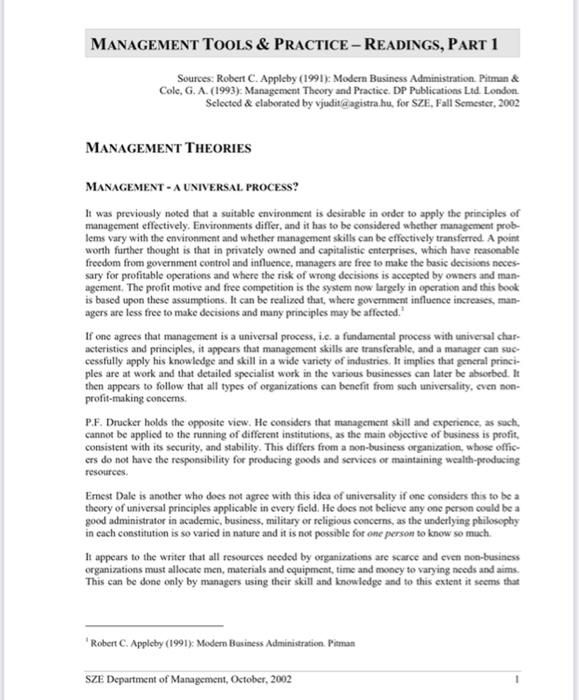
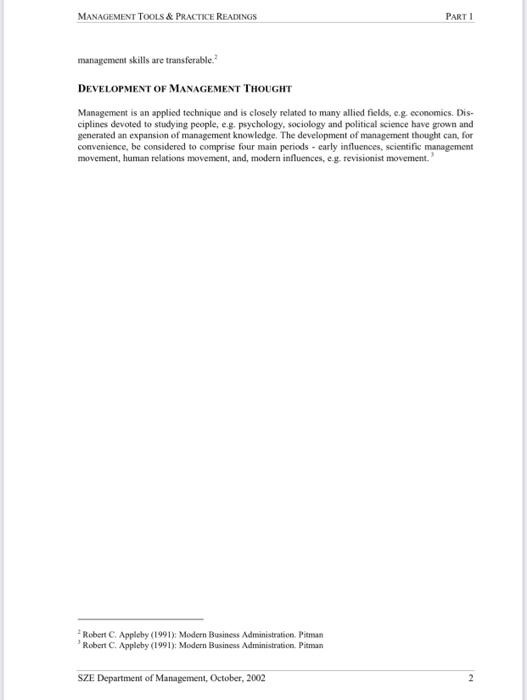
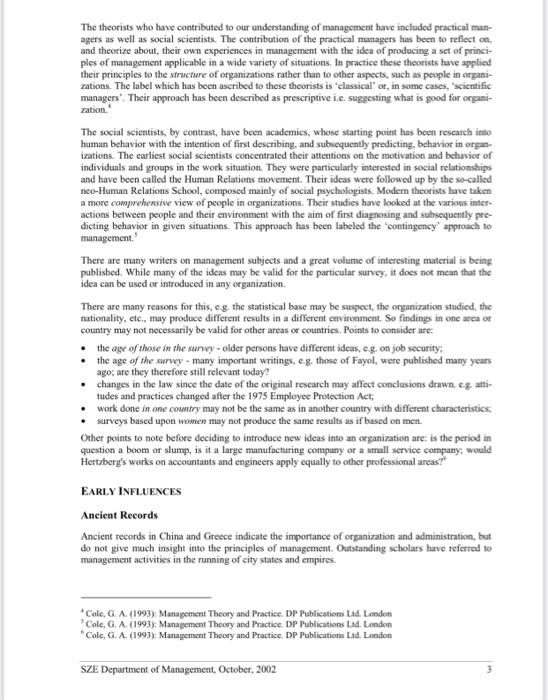
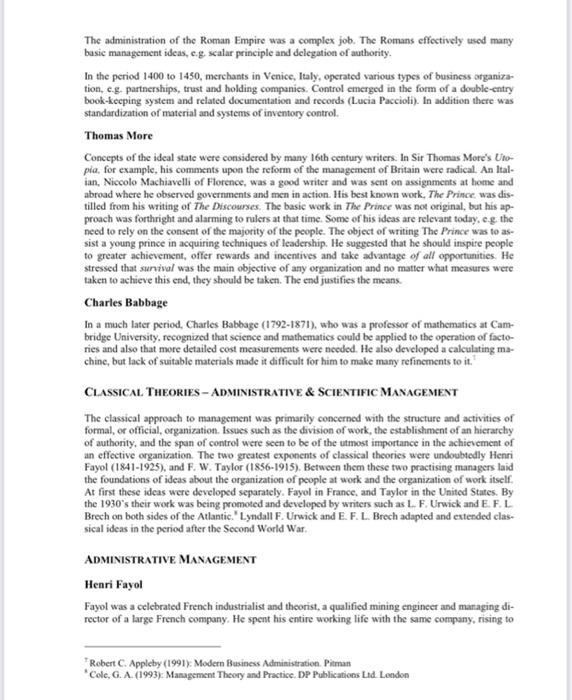
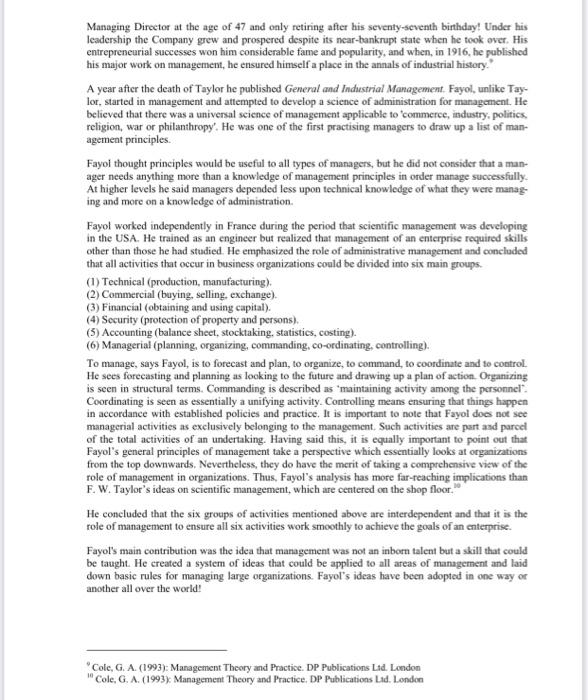
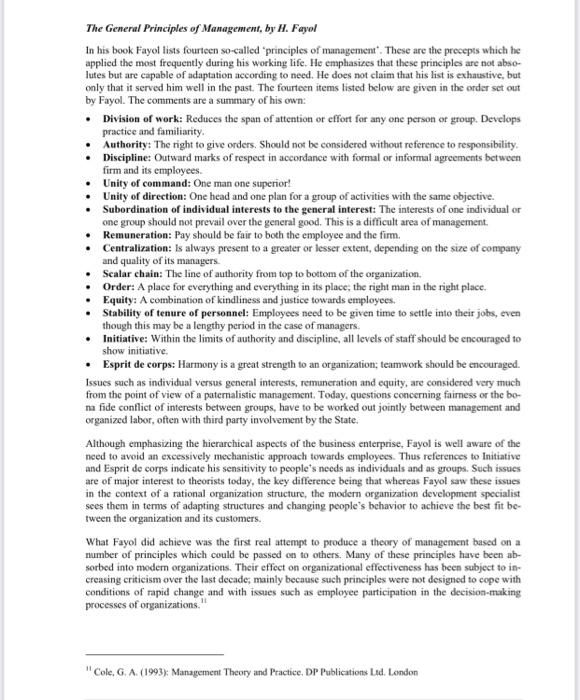
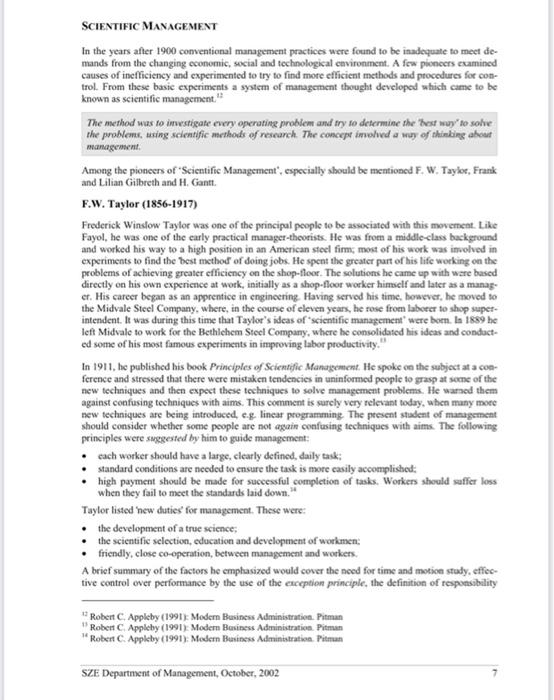
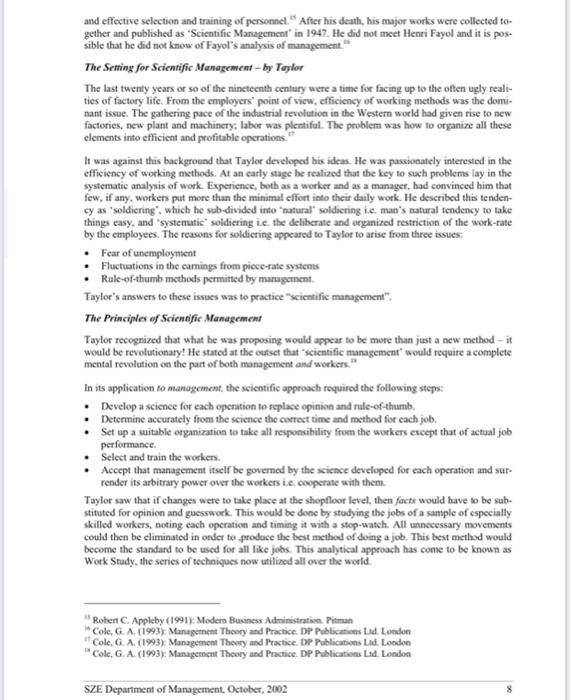
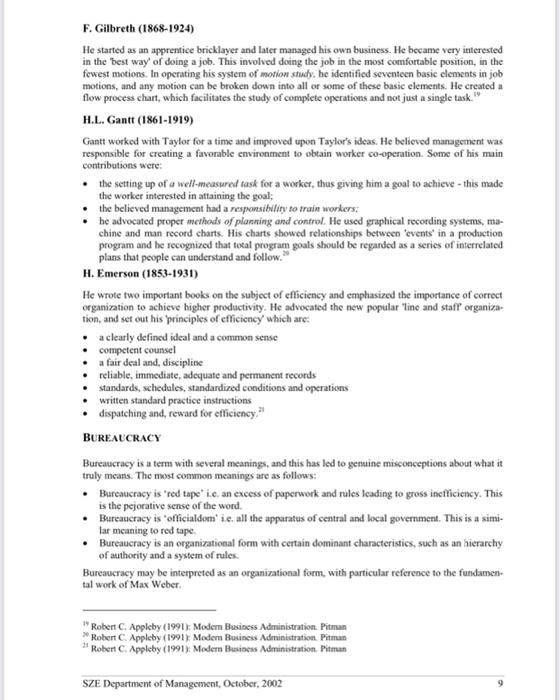
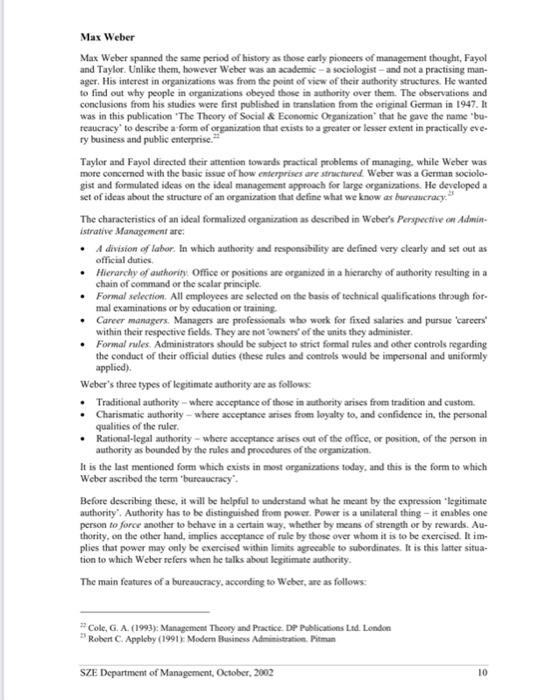
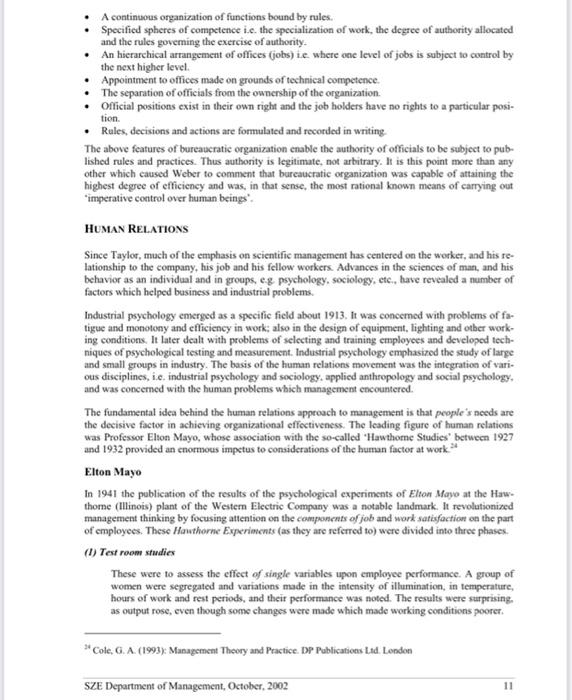
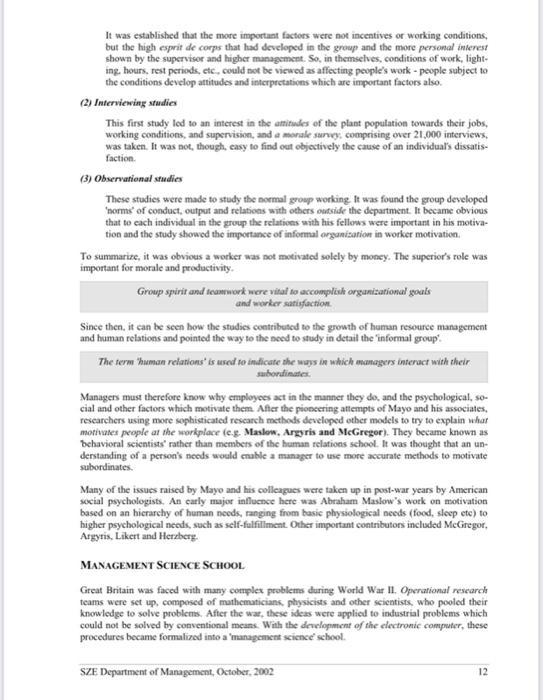
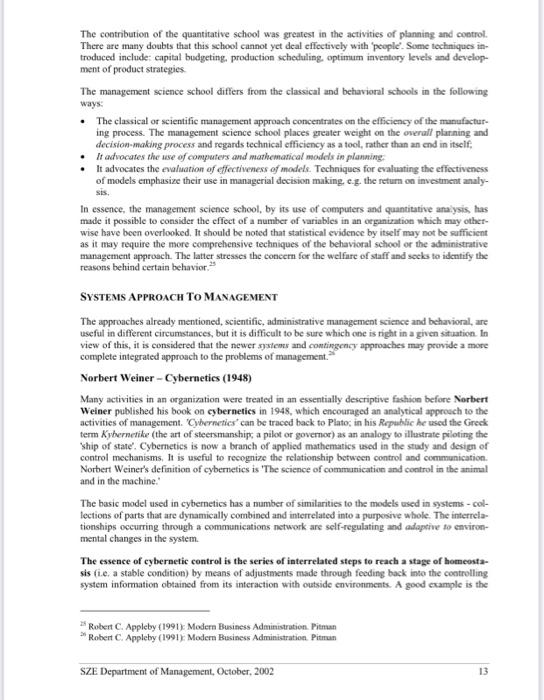
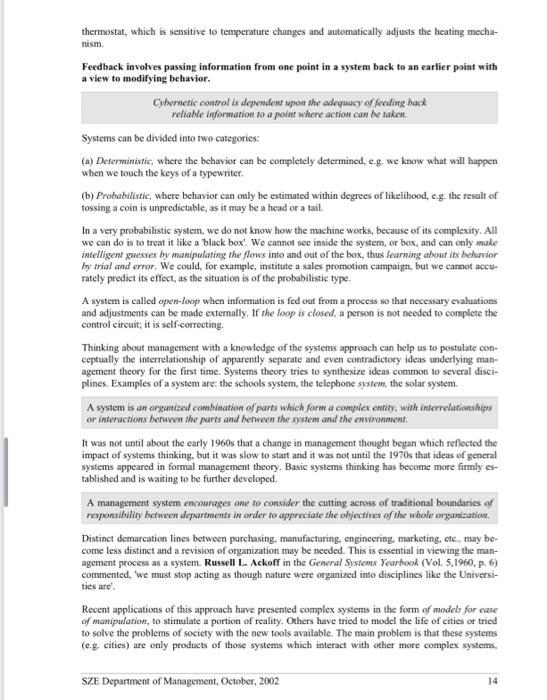
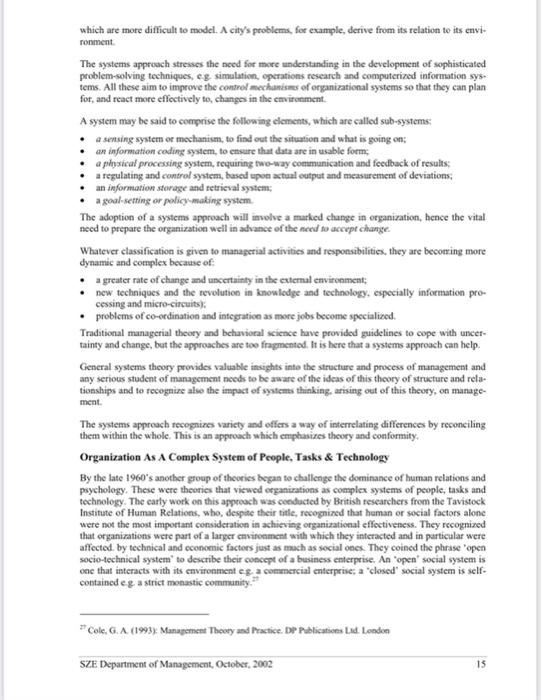
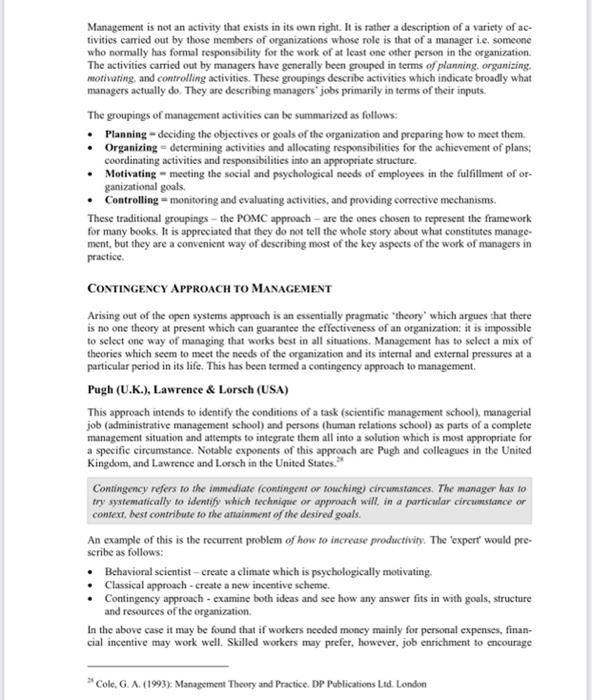
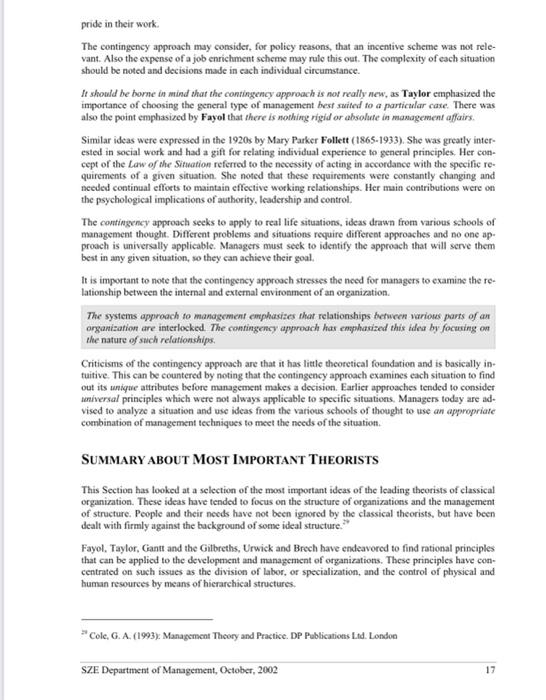
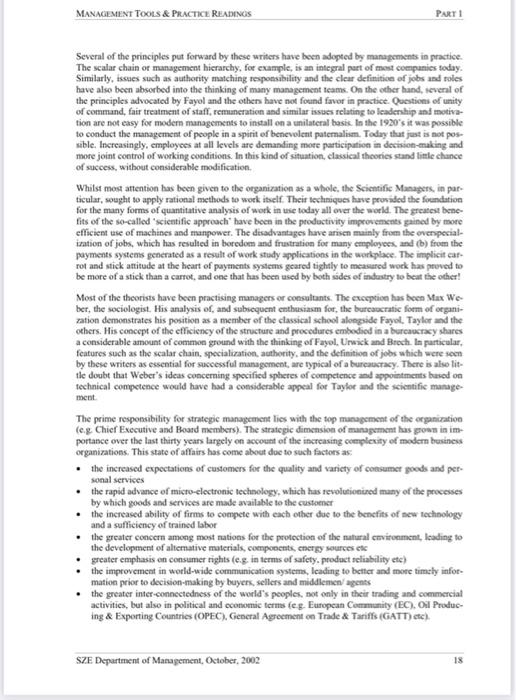
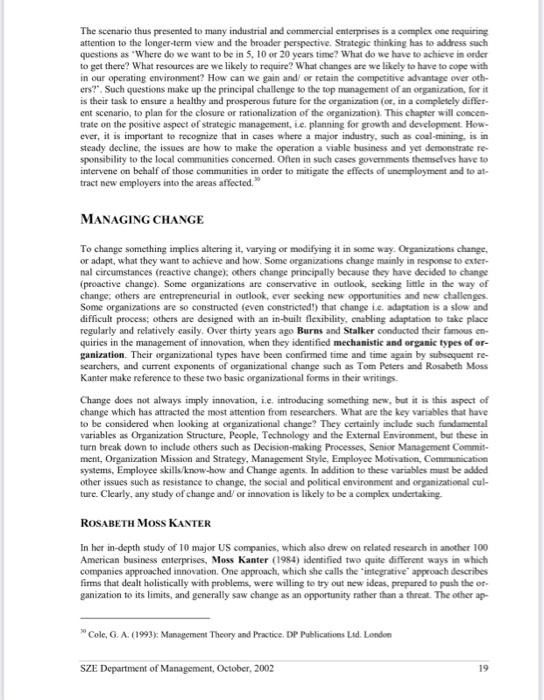


MAnAgEMENT ToOLS \& PRACTICE-ReadingS, PART 1 Sources: Robert C. Appleby (1991): Modern Business Administration. Pitman \& Cole, G. A. (1993): Management Theory and Practice. DP Publications Lid. London. Selected \& elaborated by vjudit A agistra hu, for SZL, Fall Semester, 2002 MANAGEMENT THEORIES MANAGEMENT - A UNIVERSAL. PROCESS? It was previously noted that a saitable environment is desirable in order to apply the principles of management effectively. Environments differ, and it has to be considered whether management problems vary with the environment and whether managemeat skills can be effectively transferred. A point worth further thought is that in privatcly owned and capitalistic enterprises, which have reasonable frecdom from government control and influence, managers are free to make the basic decisions necessary for profitable operations and where the risk of wrong decisions is accepted by owners and management. The profit motive and free competition is the system now largely in operation and this book is based upon these assumptions. It can be realized that, where govemment influence increases, managers are less free to make decisions and many principles may be affocted. 1 If one ayrees that management is a universal process, i.c. a fundamcntal process with universal characteristics and principles, it appears that management skills are transferable, and a manager can successfully apply his knowledge and skill in a wide varicty of industries. It implies that gencral principles are at work and that detailed specialist work in the various businesses can later be absorbed. It then appears to follow that all types of organizations can bencfit from such universality, cven nonprofit-making concerss. P.F. Drucker holds the opposite vicw, He considers that management skill and expericnce, as such, cannot be applicd to the runaing of different institutions, as the main objective of besiness is protit, consistent with its security, and stability. This differs from a non-business organiration, wbose officers do not have the responsibility for producing goods and services or maintaining wealth-producing resources. Ernest Dale is another who does not agree with this idea of universality if one considers this to be a theory of universal principles applicable in every ficld. He does not believe any one perwon could be a good administrator in academic, business, military or religious concerns, as the underlying philosophy in cach constitution is so varied in nature and it is not possible for one person to know so much. It appears to the writer that all resources needed by organimations are scarce and even non-business organizations must allocate men, materials and cquipment, time and moncy to varying necds and aims. This can be done oaly by managers using their skill and knowledge and to this exient it secms that "Robert C. Appleby (1991): Modern Basiness Administration. Pitman SZE Department of Management, Ostober, 2002 management skills are iransferable.? DEVELOPMENT OF MANAGEMENT THOUGHT Management is an applicd technique and is closcly related to many allied ficlds, e.g. ceonomics. Disciplines devoted to stuxdying people, e.g. psychology, sociology and political science bave grown and gencrated an expansion of management knowledge. The development of management thought can, for convenience, be considered to comprise four main periods - carly influences, scientific management moversent, hunan relations movement, and, modern influences, e.g. revisionist movement. 1 Robett C. Appicby ( 1991): Modern Besithess Administration. Pitman 3 Robert C. Nppleby (1991): Modern Business Administration. Pitman The theorists who have contribeted to our understanding of management have included practical managers as well as social scientists. The contribution of the practical managers has been to reflect cn. and theorize about, their own experiences in management with the idea of producing a set of principles of management applicable in a wide variety of situations. In practice these theorists have applied their principles to the structure of organizations rather than to other aspects, such as people in orzanizations. The label which has been ascribed to these theorists is "classical" or, in some cases, "scientific managers". Their approach has been described as prescriptive i.e. suggesting what is good for organization." The social scientists, by contrast, bave been academics, whose starting point has been rescarch into haman behavior with the intention of first describing, and subsequently predicting, behavior in organiations. The earliest social scientists concentrated their attentions on the motivation and behavior of individuals and groups in the work situation. They were particularly interested in social relationships and have been called the Human Relations movement. Their ideas were followed up by the so-called neo-Human Relations School, composed mainly of social prychologists, Modem theorists have taken a more conjpehencive view of people in organizations. Their studies have looked at the varioes interactions between people and their environment with the aim of first diagnosing and subsequently predicting behavior in given situations. This approach has been labeled the "contingency' approach to management. 3 There are many writers on management subjects and a great volume of interesting material is being pablished. While many of the ideas may be valid for the particular survey, it does not mean that the idea can be used or introduced in any organization. There are many reasons for this, e.g. the statistical base may be suspect, the organization studied, the tationality, cic,, may produce different results in a different environment. So findiags in one arca of country may not necessarily be valid for other areas or countries. Points to consider are: - the age of those in the surwy - older persons have different ideas, e. g, on job security; - the age of the sidryy - many important writings, eg, those of Fayol, were published many years ago; are they therefore still relevant today? - changes in the law since the date of the original rescarch may affect conclusions drawn. c-g, attitudes and practices changed after the 1975 Employee Protection Act; - work done is one coumtry may not be the same as in another country with different characteristics: - sarveys based upon women may not produce the same results as if based on men. Other points to note before deciding to introduce new ideas into an organization are: is the period in question a boom or slump, is it a large manufacturing company or a small service company, would Hertaberg's works on accountants and engineers apply equally to other professional areas? EARLY INFLUENCES Ancient Records Ancient records in China and Greece indicate the importance of organization and administration, but do not give much insight into the principles of management. Outstanding scholars have referred to management activities in the running of city states and cmpires. "Cole, G. A. (1993): Management Theory and Practiec. DP Publications LAd. London "Cole, G. A. (1993): Management Theory and Practice. DP Publications Lid. Londen "Cole, G. A. (1993): Management Theory and Practice. DP Publications Lid. London SZE Department of Management, October, 2002 The administration of the Roman Empire was a complex job. The Romans effectively used many basic management ideas, e.g. scalar principle and delegation of authority. In the period 1400 to 1450, merchants in Venice, Italy, operated various types of business arganization, c.g. partnerships, trust and holding companies. Control cmerged in the form of a double-entry book-keeping system and related documentation and records (Lucia Paccioti). In addition there was standardization of material and systems of inventory control. Thomas More Concepts of the ideal state were considered by many l6th century writers. In Sir Thomas More's Uiopia, for example, his comments upon the reform of the management of Britain were radical. An ltalian, Niccolo Machiavelli of Florence, was a good writer and was sent on assignments at home and abroad where he observed governments and men in action. ltis best known work. The Prince, was distilled from his writing of The Discourses. The basie work in The Prince was not original, but his approach was forthright and alarming to rulers at that time. Some of his ideas are relevant todry, e.g. the need to rely on the consent of the majority of the people. The object of writing The Prince was to assist a young prince in acquiring techniques of leadership. He suggested that he should inspire people to greater achievement, offer rewards and incentives and take advantage of all opportuaties. He stressed that surival was the main objective of any organization and no matter what measures were taken to achieve this end, they should be taken. The end justifies the means. Charles Babbage In a much later period, Charles Babbage (1792-1871), who was a professor of mathematics at Cambridge University. recognized that science and mathematics could be applied to the operation of factories and also that more detailed cost measurements were needed. He also developed a calculating machine, but lack of suitable materials made it difficult for him to make many refincments to it. CLASSICAL. THEORIES - ADMINISTRATIVE \& SCIENTIFIC MANAGEMENT The classical approach to management was primarily concerned with the structure and activitics of formal, or official, organization. Issues such as the division of work, the establishment of an hicrarchy of authonity, and the span of control were seen to be of the utmost importance in the achievement of an effective organization. The two greatest exponents of classical theories were undoubtedly Henri Fayol (1841-1925), and F. W. Taylor (1856-1915). Between them these two practising managers laid the foundations of ideas about the organization of people at work and the organization of work itself. At first these ideas were developed separately. Fayol in France, and Taylor in the United States. By the 1930's their work was being promoted and developed by writers such as L. F. Urwick and E. F. L. Brech on both sides of the Atlantic. "Lyndall F. Urwick and E. F. L. Brech adapted and extended classical ideas in the period after the Second World War. ADMINISTRATIVE MANAGEMENT Henri Fayol Fayol was a celebrated French industrialist and theorist, a qualified mining engineer and managing director of a large French company. He spent his entire working life with the same company, rising to TRobertC.Applsby(1991):ModernBusinessAdministration.Pilman "Cole, G. A. (1993): Management Theory and Practice. DP Pullications Lid. Lendon SCIENTIFIC MANAGEMENT In the years after 1900 conventional management practices were found to be inadequate to meet demands from the changing economic, secial and technologikal environment. A few pionecrs cxamined causes of inefliciency and experimented to try to find more efficient methods and procedures for control. From these basic experiments a system of managernent thought developed which came to be known as scientific management. k2 The method was to imvetigate cury operating problcm and try to determine the 'bout my's' solve the problems, axing scientific merhods of reseanch. The concept inwhed a my of thimbing abour management. Among the pioneers of "Scientific Management', especially should be mentioned F. W. Tayloc, Frank and Lilian Gibleth and H. Gantt. F.W. Taylor (1856-1917) Frederick Window Taylor was one of the principal people to be associated with this moverneat. Like Fayol, he was one of the carly practical manager-theoriss. He was from a middle-claxs backeround and worked his way to a high position in an American steel fim, most of his work was imvolved in experiments to find the best method of doing jobs. He spent the greater purt of his life working on the problems of achieving greater efficiency on the shop-floor. The solutions he came up with were based directly on his own expericnce at work, initially as a shop-floor worker himaclf and later as a manager. His career began as an apprentice in engincering. Having servod his time, however, he moved to the Midvale Steel Company, where, in the course of eleven years, he rose from laberer to shop superintendent. It was during this time that Taylor's ideas of "scientific management" were boen. Ia 1839 he left Midvale to work for the Bethlehem Stecl Company, where he consolidated his ideas and condocted some of his most famous experiments in improving labor productivity. In 1911, he published his book Principles of Scientific Management. He spoke ce the subject at a coeference and stressed that there were mistaken tendencies in uninformed people to grasp at some of the new techniques and then expect these techniques to solve management problems. He warned them against confusing techniques with aims. This coenment is surely very televant today, when many mose new techniques are being introduced, e.g. linear programming. The present stadent of managernent should consider whether some people are not again confusing techniques with aims. The following principles were skggested by him to guide management: - each worker should have a large, clearly defincd, daily task: - standard conditions are needed to cnsure the task is more casily accomplished: - high payment should be made for successful completion of tasis. Workers should saffer loss when they fail to meet the standards laid down. Taylor listed 'new duties' for management. These were: - the development of a true science; - the scientific selection, education and development of workmen. - friendly, close co-operation, between management and workers. A brief summary of the factors he cmphasized would cover the need for time and motion stady, effective control over performance by the use of the exception principle, the definition of responsibility 12 Robent C. Appleby (1991) Modem Besiness Administration. Pitman "Robert C. Appleby (1991) Modern Besiness Administration. Pitman 14 Robent C. Appleby (1991): Modcm Business Alministratioe. Pitman SZE Department of Management, Oetober, 2002 and effective selection and training of personnel. if After his death, his major works were collected together and published as "Scientific Management" in 1947. He did not meet Henri Fayol and it is possible that he did not know of Fayol's analysis of management. The Setting for Scientific Management - by Tarlor The last twenty years or so of the nineteenth century were a time for facing up to the often ugly realities of factory life. From the cmployers' point of view, efficiency of working methods was the dominant issue. The gathering pace of the industrial revolution in the Western world had given rise to new factories, new plant and machinery; laboe was plentifal. The problem was bow to organize all these elements into efficient and profitable opcrations. It was against this background that Tayler developed his ideas. He was passionately interested in the efficiency of working methods. At an carly stage he realined that the key to such problems lay in the systematic analysis of work. Experience, both as a worker and as a manager, had convinced him that few, if any, workers put more than the minimal effort into their daily work. He described this tendency as "soldiering", which he sub-divided into "natural" soldiering i.c. man's natural tendency to take things easy, and 'systematic" soldicring i.e. the deliberate and organized restriction of the aork-rate by the employees. The reasons for soldiering appeared to Taylor to arise from three issues: - Fear of uncmployment - Fluctuations in the camings from piocerate systems - Rule-ofthumb methods permitted by management. Taylor's answers to these issues was to practice "scicntific management". The Principles of Scientific Management Taylor recognized that what he was proposing would appear to be more than just a new method - it would be revolutionary! He stated at the outset that "scicntific management" would require a complete mental revolution on the part of both management and workers. 11 In its application to managcment, the scicntific approach requirod the following stcps: - Develop a scicnce for cach operation to replace opinion and rule-of-thumb. - Determine accurately from the scicnce the correct time and method for each job. - Set up a suitable organiration to take all responsibility from the workers except that of actual job performance. - Select and train the workers. - Accept that management itself be governed by the science developed for cach operation and sur. render its arbitrary power over the wokers i.e. cooperate with them. Taylor saw that if changes were to take place at the shopfloor level, then facte would have to be substituted for opinion and guesswork. This would be done by studying the jobs of a sample of cspecially skilled workers, noting each operation and timing it with a stop-wateh. All unnocessary movements could then be climinated in onder to produce the best method of doing a job. This best method would become the standard to be used for all like jobs. This analytical appeoach has come to be known as Work Study, the series of technicues now utilined all ower the world. 13 Robert C. Appleby (1991): Modera Business Adminstration. Pitmun in Cole, G. A. (1993): Manugernent Theory and Practice. DP Pablications Lid. Londoe 17 Cole, G. A. (1993): Managernent Theory and Practice. DP Publicativens Lud. Loodoe "Cole, G. A. (1993): Managernent Theory and Practice. DP Publications Lid. London F. Gilbreth (1868-1924) He started as an apprentice bricklayer and later managed his own business. He became very interested in the 'best way' of doing a job. This involved doing the job in the most comfortable position, in the fewest motions. In operating his system of motion study, he identified seventeen basie elements in job motions, and any motion can be broken down into all or some of these basic elements. He created a flow process chart, which facilitates the study of complete operations and not just a single task. 19 H.L. Gantt (1861-1919) Gantt worked with Taylor for a time and improved upon Taylor's ideas. He believed management was responsible for creating a favorable emvironment to obtain worker co-operation. Some of his main contributions were: - the setting up of a well-measured task for a worker, thus giving him a goal to achieve - this made the worker interested in attaining the goal; - the believed management had a responsiblity to train workers: - be advocated proper methods of planning and control. He used graphical recording systems, machine and man record charts. His charts showed relationships between 'events' in a production program and he recognized that total program goals should be regarded as a series of interrelated plans that people can understand and follow. H. Emerson (1853-1931) He wrote two important books on the subject of efficiency and emphasized the importance of correct organization to achieve higher productivity. He advocated the new popular Tine and staff organization, and set out his 'principles of efficiency' which are: - a clearly defined ideal and a common sense - competent counsel - a fair deal and, discipline - reliable, immediate, adcquate and permanent records - standards, schedules, standardized conditions and operations - written standard practice instructions - dispatching and, reward for efficiency. BUREAUCRACY Bureaucracy is a term with several meanings, and this has led to genaine misconceptions about what it truly means. The most comumon meanings are as follows: - Bureaucracy is "red tape' i.c. an excess of paperwork and rules leading to gross inefficiency. This is the pejorative sense of the word. - Bureaucracy is 'officialdom' i.e. all the apparatus of central and local government. This is a similar meaning to red tape. - Bureaucracy is an organizational form with certain dominant characteristics, such as an hicrarchy of authority and a system of rules. Bureaucracy may be interpreted as an organizational form, with particular reference to the fundamental work of Max Weber. Max Weber Max Weber spanned the same period of history as those early pioneers of management thought, Fayol and Taylor. Unlike them, bowever Weber was an academic - a sociologist - and not a practising manager. His interest in organirations was from the point of vicw of their authority stroctures. He wanted to find out why people in organimations obcyed those in authority over them. The observations and conclusions from his studies were first published in translaticn from the original German in 1947. It was in this publication 'The Theory of Social \& Economic Organization' that be gave the name "bureaucracy' to describe a-form of organiration that exists to a greater or lesser exient in practically every business and public enterprise. 22 Taylor and Fayol directed their attention towards practical problens of managing, while Weber was more concerned with the busic issue of how enterprises are structured. Weber was a German sociologist and formulated ideas on the idcal manapement approseh for large organizations. He developed a set of ideas about the structure of an organization that define what we know as burvucracy. The characteristics of an ideal formalized organiration as described in Weber's Perspoctive on Admin. istrative Management are: - A division of labor. In which authority and responsibility are defined very clearly and set out as afficial duties. - Hienarchy of authority. Office or positions are erganized in a hicrarchy of authority resulting in a chain of command or the scalar principle - Formal selection. All employecs are selected on the basis of technical qualifications through formal examinations or by cducation or training. - Career managers. Managers are professionals who work for fived salaries and pursue 'careers' within their respective fields. They are not 'owners' of the anits they administer. - Formal rules. Administrators shocld be subject to strict formal rules and other controls regarding the conduct of their official duties (these fules and controls would be impersonal and uniformly applied). Weber's three types of legitimate authority are as follows: - Traditional authority - where acecptance of those in authority arises from tradition and custom. - Charismatic authority - where acceptance arises from loyalty to, and confidence in, the personal qualities of the ruler. - Rational-legal authority - where acceptance arises cut of the office, or position, of the person in authority as bounded by the rules and procedures of the organication. It is the last mentioned form which exists in most organizations today, and this is the form to which Weber ascribod the term 'bureacracy". Before describing thesc, it will be helpfol to understand what he meant by the expression "legitimate authority". Authority has to be distinguished from power. Power is a unilateral thing - it enables one person to force another to behuve in a certain way, whether by means of strength or by rewuds. Authority, on the other hand, implies acceptance of rale by those over whom it is to be exercised. It implies that power may only be exercised within limits agrocable to subordinates. It is this latter situation to which Weber refers when be talks about legitimate authority. The main features of a bureaucracy, acconding to Weber, are as follows: " Cole, G, A. (1993): Management Theory and Practice. DP Poblications Lad. London "20bert C. Appleby (1991) Modem Blusinses Almitiotration. Pitman SZE Department of Management, October, 2002 10 - A continuous organization of functions bound by rules. - Specified spheres of competence i.e. the specialiration of work, the degree of authority allocated and the rules goveming the exercise of authority. - An hierarchical arrangement of offices (jobs) i.e. where one level of jobs is sabject to control by the next higher level. - Appointment to offices made on grounds of technical competence. - The separation of officials from the ownership of the organization. - Official positions cxist in their own right and the job holders have no rights to a particular position. - Rules, decisions and actions are formulated and rocorded in writing. The above features of bureaucratic organization enable the authority of officials to be subject to published rules and practices. Thus authority is legitimate, not arbitrary. It is this point more than any other which caused Weber to comment that burcaucratic organization was capable of attaining the highest degree of efficiency and was, in that sense, the most rational known means of carrying out "imperative control over human beings". HUMAN REL.ATIONS Since Taylor, much of the emphasis on scientific management has centered on the worker, and his relationship to the company, his job and his fellow workers. Advances in the sciences of man, and his behavior as an individual and in groups, eg psychology, sociology, etc., have revealed a number of factors which helped business and industrial problems. Industrial psychology emerged as a specific ficld about 1913. It was concemed with problems of fatigue and monotony and efficiency in work; also in the design of equipment, lighting and otber working conditions. It later dealt with problems of selecting and training employees and developed techniques of psychological testing and measurement. Industrial psychology cmphasized the study of large and small groups in industry. The basis of the human relations movement was the integration of various disciplines, i.e. industrial psychology and sociology, applied anthropology and social psychology, and was concemed with the human problems wbich management encountered. The fundamental idea behind the human relations approach to management is that people's needs are the decisive factor in achieving organizational effectiveness. The leading figure of human relations was Professor Elton Mayo, whose association with the so-called 'Hawthome Studies' between 1927 and 1932 provided an cnormous impstus to considerations of the human factor at work 3 Elton Mayo In 1941 the publication of the results of the prychological experiments of Elion Mayo at the Hawthome (Illinois) plant of the Western Electric Company was a notable landmark. It revolutionized management thinking by focusing attention on the componcnts of job and work satisfaction on the part of employess. These Hawthome Experiments (as thcy are referred to) were divided into three phases. (I) Test room studies These were to aksess the effect of single variables upon employee performance. A group of women were segregated and variations made in the iatensity of illumination, in temperature, hours of work and rest periods, and their performance was noted. The results were surprising. as output rose, even though some changes were made which made working conditions poorer. It was established that the more important factors were not incentives or working conditions, but the high esprit de corps that had developed in the group and the more personal inkerest shown by the supervisor and higher management. So, in themselves, conditions of work, lighting hours, rest periods, etc. could not be viewed as affecting people's work- people subject to the conditions develop attitudes and interpretations which are important factors also. (2) Interviewing studie This firs study led to an interest in the amitudes of the plant population towards their jobs, working conditions, and supervision, and a monale sanvy, comprising over 21,000 interviews, was taken. It was not, though, easy to find out objectively the cause of an individual's dissatisfaction. (3) Observational sudies These studies were made to study the normal growp working It was found the group developed 'norms' of conduct, outpul and relations with others outside the department. It became obvious that to cach individual in the group the relatioes with his fellows were important in his motivation and the study showed the importance of informal organisarion in worker motivation. To summarise, it was obvious a worker was not motivated solely by money. The superior's role was important for morale and productivity. Group spirit and thamenork wcre vital to accomplivh organizarional goals and wevker satisfaction. Since then, it can be seen bow the studies coetributed to the growth of haman resource management and human relations and pointed the way to the need to study in detail the 'informal group'. The term human relanions' is asol to indicate ahe wass in which managers interact with their subordinates. Managers must therefore know why cmployees act in the manner they do, and the psychological, social and other factors which motivate them After the pioneering attempts of Mayo and his associates, researchers using more sophisticated rescarch methods developed other models to try to explain what motivates people at the workplace (c.e. Maslew, Arzyris and MeGreger). They became known as behavioral scientists' rather than members of the human relations school. It was thonght that an understanding of a person's needs would cmable a manager to tuse more accurate methods to motivate subordinates. Many of the issues raised by Mayo and his colleagues were taken up in post-war years by American social psychologists. An carly major influcnce here was Abraham Maslow's wotk on motivation based on an hicrarchy of human needs, ranging from basic physiological needs (food, slocp etc) to higher psychological needx, such as self-fulfillment. Other important contributors included MeGregor, Argyris, Likert and Heralerg. MANAGEMENT SCIENCE SCHOOL. Great Britain was faced with many complet problems during World War II. Operational research teams were set up, composed of mathematicians, physicists and other seicatists, who pooled their knowledge to solve problens. After the wae, these ideas were applied to industrial problems which could not be solved by conventional means. With the derelopment of the clectronic computer, these procedures became formalized into a 'imanagement science' school. SZE Department of Management, October, 2002 12 The cootribution of the quantitative school was greatest in the activities of planning and control. There are many doubts that this school cannot yet deal effectively with 'people'. Some techniques introduced include: eapital budgeting, production scheduling, optimum inventory levels and development of product strategies. The management science school differs from the classical and behavioral schools in the following ways: - The classical or scientific management approach concentrates on the efficiency of the manufacturing process. The management science school places greater weight on the overail plarning and decision-making process and regards technical efficiency as a fool, rather than an end in itself, - It advocates the use of computers and mathemanical modils in planning- - It advocates the evaluation of effectiveness of models. Techniques for evaluating the effectivencss of models emphasize their use in managerial decision making, e.g. the return on investment analysis. In essence, the management science school, by its use of conputers and quantitative analysis, has made it possible to consider the effect of a number of variables in an organization which may otherwise have been overlooked. It should be noted that statistical evidence by itself may not be safficient as it may require the more comprehensive techniques of the behavioral school or the administrative management approach. The latter stresses the concern for the welfare of staff and secks to identify the reasons behind certain behavior 23 SYSTEMS APPROACH TO MANAGEMENT The approaches already mentioned, scientific, administrative management science and behavioral, are useful in different circumstances, but it is difficult to be sure which one is right in a given situation. In view of this, it is considered that the newer systews and contingency approaches may peovide a more complete integrated approach to the problemis of management. 2 Norbert Weiner - Cybernetics (1948) Many activities in an organization were treated in an essentially descriptive fashion before Norbert Weiner published his book on cybernetics in 1948, which encouraged an analytical approsch to the activities of managenent. 'Cyberneties' can be traced back to Plato; in his Rrpublic he used the Greck term Kybernetibe (the art of steenmanshipy a pilot or governot) as an analogy to illastrate piloting the 'ship of state'. Cybernetics is now a branch of applied mathematics used in the study and design of control mechanisms, It is useful to recognize the relationship between control and communication. Norbert Weiner's definition of cybernetics is 'The science of communication and control in the animal and in the machine." The basic model used in cybernetics has a number of similarities to the models used in systems - collections of parts that are dynamically combined and interrelated into a purposive whole. The interrelationships occurring through a communications network are self-regulating and addaptive to environmental changes in the system. The cssence of cybernetic control is the series of interrelated steps to reach a stage of homeostasis (i.e, a stable condition) by means of adjustments made through feeding back into the controlling system information obtained from its interaction with outside cnvironments. A good cxample is the 35 Robert C. Appleby (1991) Modern Business Administration. Pitman as Robert C. Appleby (1991): Modern Business Administration. Pitmun SZE Department of Management, October, 2002 13 thermostat, which is sensitive to temperature changes and automatically adjusts the heating mechanism. Feedback involves passing information from one point in a system back to aB earlier point with a view to modifying behavior. Cybernetic control is dependent upon the adeyuacy of feeding baek reliable information to a point where action can be raken. Systems can be divided into two categories: (a) Deferminivicic, where the behavior can be completely determined, e.g. we know what will happen when we touch the keys of a typewriter. (b) Probabilistic, where behavior can only be estimated within degrees of likelihood, e.g. the result of tossing a coin is unpredictable, as it may be a head or a tail. In a very probabilistic system, we do not know how the machine works, because of its complexity. All we can do is to treat it like a black box: We cannot see inside the system, or box, and can only make intelligent guesses by manipulating the flows into and out of the box, this learning about its behavior by trial and error. We could, for example, institute a sales promotion campaign, but we cannot accurately predict its effect, as the situation is of the probabilistic type. A system is called open-loop when information is fed out from a process so that necessary evaluations and adjustments can be made extemally. If the loop is closed, a person is not needed to complete the control circuit; it is self-correcting. Thinking about management with a knowledge of the systems approach can belp us to postulate conceptually the interrelationship of apparently separate and even contradictory ideas underlying management theory for the first time. Systems theory tries to synthesire ideas common to several disciplines. Examples of a system are: the schools system, the telephone system, the solar system. A system is an organited cambination of parts which form a complex crtity, with interrelationships or interactions between the parts and berween the system and the emvironment. It was not until about the early 1960 s that a change in management thought began which reflected the impact of systems thinking, but it was slow to start and it was not until the 1970 s that ideas of general systems appeared in formal management theory. Basic systems thinking has become more firmly established and is waiting to be further developed. A management system encourages one to consider the cutting across of traditional boundaries of responsibility between departments in order to appreciate the objectiver of the whole organization. Distinct dernarcation lines between purchasing, manufacturing, engincering, marketing, etc- may become less distinct and a revision of organization may be needed. This is essential in viewing the management process as a system. Russell L. Ackoff in the General Systens Yearhook (Vol. 5, 1960, p, 6) commented, we must stop acting as though nature were organized into disciplines like the Universities are'. Recent applications of this approach have presented complex systems in the form of model for ease of manipulation, to stimulate a portion of reality. Onhers have tried to model the life of cities or tried to solve the problems of society with the new tools available. The main problem is that these systems (c.g. eities) are only products of those systems which interact with other more complex systems, SZE Department of Management, October, 2002 14 which are more difficult to model. A city's problems, for example, derive from its relation to its environment. The systems approach stresses the need for more understanding in the developenent of sophisticated problem-solving techniques, eg. simulation, operations research and computerized information sys. tems. All these aim to improve the control mechanisms of organizational systems so that they can plan for, and react more effectively to, changes in the emironment. A system may be said to comprise the following clements, which are called sub-systems: - a sensing systern of mochanism, to find out the situation and what is going on; - an information coding system, to cmsare that data are in usable form: - a physical processing system, requiring two-way conimunication and fcedoack of resulis: - a regulating and control system, based upon actual output and measurement of deviations; - an information storage and retricval system; - a goal-serting or policy-making system. The adoption of a systems approach will imvolve a marked change in otganization, hence the vital need to prepare the organixation well in advance of the neod to accopt change. Whatever classification is given to managerial activities and responsabilities, they are becorring more dynamic and complex because of: - a greater rate of change and uncertainty in the cuternal environment; - new techniques and the tevolution in knowlodge and technology, especially information processing and micro-circuits): - problems of co-ordination and integration as more jobs become specialized. Traditional managerial theory and behavional scicnce have provided guidelines to cope with uncertainty and change, but the approaches are too fragmentod. It is here that a systems approach can help. General systems theory provides valuable insights into the structure and process of management and any serious student of management needs to be aware of the ideas of this theory of structure and relationships and to recogrire also the impact of systemt thinkiag, arising out of this theory, on management. The systems approach recognizes varicty and effers a way of interrelating differences by reconciling them within the whole. This is an appooach which emphasires theory and conformity. Organization As A Complex System of Pcople, Tasks \& Technology By the late 1960's another group of theories began to challenge the dominance of human relations and prychology. These were theories that viewed organirations as complex systems of people, tasks and technology. The carly work on this approoch was coeducted by British researchers from the Tavistock Institute of Human Relations, who, despite their title, recognised that heman or social factors alone were not the most important consideration in achieving organizational effectiveness. They recognized that organirations were part of a larger environment with which they interacted and in particular were affected. by technical and economic facters just as mach as social oeex. They coined the phrase 'open socio-technical system' to describe their conccpt of a business enterprise. An "open' social system is eae that interacts with its environment eg. a commercial enterprise; a "closed" social system is selfcontained e. g. a strict monastic commanity. "Cole, G. A. (1993): Managencent Theory and Praxtice. DP Publicatises Lud. Londce SZE Department of Management, October, 2002 pride in their work. The contingency approach may consider, for policy reasons, that an incentive scheme was not relevant. Also the expense of a job enrichment scheme may rule this out. The complexity of cach situation should be noted and decisions made in each individual circumstance. It should be borne in mind that the contingency approach is not really new, as Taylor cmphasized the importance of choosing the general type of management best swithd to a particular caxe. There was also the point emphasized by Fayol that there is nothing rigid or absolute in management affairs. Similar ideas were expressed in the 1920s by Mary Parker Follett (1865-1933). She was greatly interested in social work and had a gift for relating individual experience to general principles. Her concept of the Law of the Sinkation referred to the necessity of acting in accordance with the specific requirements of a given situation. She noted that these roquirements were constantly changing and needed contimal efforts to maintain effoctive working relationships. Her main contributions were on the psychological implications of authority, leadership and control. The contingency approach seeks to apply to real life situations, ideas drawn from various sehools of management thought. Different problems and sifuations require different approaches and no one approach is universally applicable. Managers must seck to identify the approach that will serve them best in any given situation, so they can achieve their goal. It is important to note that the contingency approoch stresses the need for managers to examine the relationship between the internal and external cmvironment of an organization. The systems approach to manasement emphasizes that relationships between variotas parts of an organization are interlocked. The contingency approach har emphasized this iffa by focaring on the nature of such relationshipo. Criticisms of the contingency approach are that it has little theoretical foundation and is basically infuitive. This can be countered by noting that the contingency approach examines cach situation to find out its unigue attributes before management makes a decision. Earlier approaches tended to consider iemversal principles which were not always applicable to specific situations. Managers today are advised to analyze a situation and use ideas from the various schools of thought to use an appropriate combination of management techaiques to mect the needs of the situation. SUMMARY ABOUT MOST IMPORTANT THEORISTS This Section has looked at a selection of the most important idcas of the leading theorists of classical organization. These ideas have tended to focus on the structure of organizations and the management of structure. People and their necds have not been ignored by the classical theorists, but have been dealt with firmly against the background of some ideal structure." Fayol, Taylor, Gantt and the Gitbreths, Urwick and Brech have endeavored to find rational principles that can be applied to the development and management of organirations. These principles have concentrated on such issues as the division of labor, or specialization, and the control of physical and human resoures by means of hierarchical structures. "Cole, G.A. (1993): Management Theory and Practice. DP Publications Lid. Londoe Several of the principles put forward by these writers have been adopted by manapements in practice. The scalar chain of managemsent hierarchy, for example, as an integral part of most coenpanies today. Similarly, issaes such as authotity matching responsibility and the clear definitioe of jobs and roles have also been absorbed into the thinking of mamy management teams. On the other hand, several of the principlss advocated by Fayol and the othen have not fosind favor in practice. Qoestions of unity of commund, fair treatment of staff, remuneraticn and similar issues relating to leadenhip and motivation are not easy for modern managcments to indall on a tilateral basic. In the 1920 's it was possible to conduct the management of poople in a spirit of benevolent patemalism. Todmy that just is not possible. lncreasingly, employees at all levels are demanding more participation in decixion-making and more joint control of working conditions. In this kind of situation. classical thoories stand limle chance of success, without considerable modification. Whilst most attention bas been given to the otganization as a whole, the Scicntific Manapers, in particular, sought to apply rational methods to woek itself. Their technigues have provided the foundation for the many forms of quantitative analysis of work in use today all over the world. The greatest benefits of the so-called "scientific approach" have becn in the productivity improvemenes gained by more efficient tse of machines and manpower. The dtradvantages have arisen mainly from the evenpecialination of jobs, which has resulied in boredom and frustration for many employees, and (b) from the payments systens generated as a result of woek stady applications in the workplace. The implicit catrot and stick attitude at the heart of payments systems geared tightly to measared work has proved to be more of a stick than a carrot, and one that has been used by both sides of indastry to beat the other! Most of the theorists have been practising managers or consultants. The execptice has been Max Weber, the sociologist. His analysis of, and subvequent enthasiasm for, the bureacoratic form of organization demonstrates his position as a member of the classical school alongide Fayol. Tayler and the others. His concept of the efficiency of the structure and procedures embodied in a bureaucracy shares a considerable amount of common ground with the thinking of Fayol, Urwick and Brech. In particular, features such as the scalar chain, specialiration, authority, and the definition of jobs which were secn by these writers as essential for successful management, are fypical of a burcataracy. There is alse little doubt that Weber's ideas concerning specified spheres of competence and appointments bused on fechnical competence would have had a considerable appeal for Taylot and the scientific management The prime responsibility for strategic managenent lies with the top management of the arganiration (c.e. Chicf Exccutive and Boand nembers). The strategic dimsnsion of managkment has gows in importance over the last thirty years largely on account of the increasing complexity of modern bosiness organizations. This state of affairs has come about doe to such factors as: - the increased expoctations of customers for the quality and variety of consumer goods and personal services - the rapid advance of micro-electronic technology, which has revolutionined many of the processes by which goods and services are made available to the custoener - the increased ability of firms to compete with each other doe to the bencfits of new rechnology and a sufficiency of trained labor - the greater concern among most nations for the protection of the nutural cmvitunment, lsading to the development of aliemative materials, compoocnts, energy sources etc - greater emphasis on consumer tights (e.g, in termis of safety. product scliability etc) - the improvement in wotld-wide communication systems, leading to beiter and mose timehy information prior to decision-making by buycrs, sellers and middlensen/ agents - the greater inter-connectedness of the world's peoples, not only in their trading and coenmercial activitics, but also in political and oconomic terms (e. E. European Community (EC). OAl Producing \& Exporting Ceuntries (OPEC), General Agreement on Trade \& Tariffs (GATT) cte). S7E Depurtment of Maragement, October, 2002 18 The scenario thus presented to many industrial and commercial enicmpises is a cornplex onc tequiring attention to the longer-term view and the broader perspective. Strategic thinking has to address such questions as "Where do we want to be in 5,10 or 20 years time? What do we have to achicve in order to get there? What resources are we likely to require? What changes are we likely to have to cope with in our operating cmvironment? How can we gain and of retain the competitive advantage over others?". Such questions make up the principal challenge lo the top mamagement of an organiration, for it is their task to ensure a healthy and prosperous future for the organization (ot, in a completely differcnt scenario, to plan for the closure or rationalization of the organization). This chapter will concentrate on the positive aspect of strategic management, l.e. planning for growth and development. Howcver, it is important to recognize that in cases where a major industry, such as coal-mining, is in steady decline, the issies are how to make the operation a viable business and yet demonstrate responsibility to the local communities concemed. Often in such cases governments themselves have to intervene on behalf of those communities in order to mitigate the effects of unemployment and to attract new employers into the areas affected. MANAGING CHANGE To change somcthing implics altering it, varying or modifying it in some way. Organimationi change, of adapt, what they want to achieve and how. Some organizations change mainly in response to external circumstances (reactive change): ohers change principally because they have decided lo change (proactive change). Some orgarizations are conservative in outlook, sccking little in the way of change; others are entreprencurial in outlook, ever secking new opportunities and new challenges. Some organizations are so constructed (even constricted!) that change i.c. adapeation is a slow and difficult process; others are designed with an in-built flexibility, cnabling adaptation to take place regularly and relatively casily. Over thirty years ago Burns and Stalker conductod their famous enquiries in the management of innovaticn, when they identified mechanistic and organic types of organization. Their organizational types have been confirmed time and time again by sabseguent researchers, and current exponents of ocganizational change sach as Tom Pcters and Rosabeth Moss Kanter make reference to these two basic organizational forms in their writings. Change does not always imply innovation, i.e. introducing something new, but it is this aspect of change which has attracted the most attention from researchcrs. What are the key variables that have to be considered when looking at otganizational change? They certainly include sach fundamental variables as Organization Structure, People, Technology and the External Environrment, but these in turn break down to include others such as Decision-making Processes, Senor Maragement Commitment, Organimation Mission and Strategy, Management Style, Employec Motivation, Connmanication systems, Employee skills/know-how and Change agents. In addition to these variables muat be added other issues such as resistance to change, the social and political cevironment and organizational culture. Clearly, any study of change and' or innovation is likely to be a complex undertaking. ROSABETH MOSS KANTER In her in-depth study of 10 major US companies, which also drew on related research in another 100 American business enterprises, Moss Kanter (1984) identified two quite different ways in which companies approached innovation. One approach, which she calls the "integrative' approach describes firms that dealt holistically with problems, were willing to try out new ideas, prepared to puth the organization to its limits, and generally saw change as an opportunity rather than a threat. The other ap- proach, by contrast, compartmentalized its problem-solving saw the organization as a cotlection of segments rather than as otganic whole, deall with change within scgments/compurtments and was anwilling to alter the balance of the overall structure. This approuch she calls the "segmentalist" approach. It soon became clear to her that innovation - the introdoction not just of ncw prodocts and new technology, bet also of new ideas and practices - was much better handled by integrative cotrpanies than by the segmentalists. The most important motive for innovation in a business enterprise is, according to Moss Kanter, to improve the organization's ability to meet and satisfy customer needs. Fer companies to become integrative they need to develop three new sets of skills: - Power skills - i.e. skills in persading others to invest time and resources in new (and riaky) initiatives - Skills in managing problems arising from team-working and employec participation - An understanding of how change is designod and constructed in an organization. These are points which are taken up by other writers, including Peters, whose idcas will be referned to shortly. In dealing with issues of resistance to change and overcoming incrtia ('roadolocks to innowation'). Moss Kanter suggests a number of possible actions, which can be summarived as follows: - As a pre-requisite to change, top management must be personally commithed to supporting innovation and must learn to think inteyratively - A 'culture of pride' should be encouragod within the organization, in which achicvements are highlighted and where experienced innovators serve as consultants to other parts of the organiration - Access to power sources (managencent committees cte) shoald be calarged to improve scpport for innovatory experimental proposals - Lateral communication should be improved. Cross-functional links should be devclopod, and staff mobility should be encouraged - Unnecessary layers of hierarchy should be reduced (i.e. a flatter structure shoald be aimod foe) and authority should be pushed downwards ("empowerment' of staff) - Information about company plans should be more widespread and given as carty as poosible to enable people to contribute to change before decisions are made (e. . by means of taik-forces. probleri-solving groups ctc). RESISTANCE TO CHANGE There is not much point in "change for change's sake', and most people need to be persuaded of the need to change. Some fear change. The reality is that every human grouping has forces within it which keep it together and provide it with stability, and yet others which provide it with a reason to change or adapt. Kurt Lewin (1951) illustrated the dilenma neatly with his classic notion of "Forcefield theory This theory suggests that all behaviof is the result of an equilibrium between two sets of opposing forses (what he calls "driving forces" and 'restraining forces'). Driving foeces push ene way ts athempt to bring about change; restraining forces push the other way in order to maintain the status quo. SZE Department of Management, October, 2002 20 DRIVING FORCES TO BRING ABOUT CHANGE - PETERS \& WATERMAN Generally speaking. human beings tend to pefer to use driving forces to bring about change. They want to 'win' by exerting pressure on those who oppose them, but, as Lewin's model sugecets, the more one side pushes, the more the ether tesiss, resulting in no change. The better way of overcom ing resistance, therefore, is by focusing on the remeval, of at lead weakening of the objections and fears of the resisting side. Thus the initial policy should be not 'How can we persuade them of our arguments for change?", but rather 'What are their objections feats, and how can we deal with them?' As a result of their studies, Peters and Waterman, identified cight attritutes of exeellence, which can be summarized briefly as fotlows: - They have a bias towards action, ie ence a problem is identified and analywd, poople are expocted to come tep with solutions - They listen to their customers - cestomer service is foremost - They encourage intemal autonomy and entrepecneunhip (and are prepurod so tolerate the inevitable failures that will occur) - Employes are held in ligh esteem, but in a performance-conscious cmvironment, expectations are bigh - They emplasixe the organiration's basie values (cullure) and demonstrate their commitmeat to them - They stick to what they know (ackowlodging that what they know increases over time) - Comples structures are avoided; divisionalired structures ase the most likely; corpontel headquarters staff are kept to the minimum - Control is loose yet tight; it is loose in that decision-making is pushed dowmurds, bet tight in that certain core values/ practices are insisted upon (e.g attention to quality, information foedback etc) - One cother important conclusion reached by Peiers and Waterman was that there was iavariably one strong individual at work in the crucial carly stages of developing the culture of excellence. In encouraging others to take up the cause of exellence, and thas increase the number of pecple willing to take up the key leadership role, Peers has written subsequently on the subject of ereellense. In his book, Thriving en Chaos (1987), he proposes some preseriptions for menaging changs, innevation and survival. The title of the book is intended to show that the external environumeet is turtelent and unstable, and managements have to develop a suitable strategy for chunge if they and their fims are to survive and win, In this book be proposes 45 prescripticens in order to realize excellenoe. SZE Department of Managenent, October, 2002 21



























